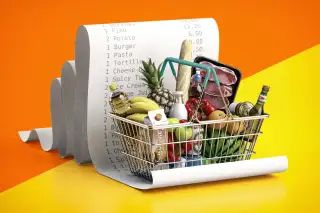Deflation vs. Disinflation: What’s Better for the Economy?

New inflation data comes out Wednesday. And while consumer price index updates are always closely watched, this data drop is primed to be particularly scrutinized as the Federal Reserve mulls its approach to future interest rate hikes, which will affect the U.S. economy at large.
Inflation has proven sticky lately, and shoppers continue to feel the pinch on their wallets. But while you may think you want prices to decrease, experts say to be careful what you wish for.
Deflation is when prices come down directly, and disinflation is when price increases slow down. Differentiating is key: Disinflation is typically preferable to widespread deflation because it keeps the economy functioning.
Read on to learn more.
What is the difference between deflation and disinflation?
It’s common knowledge that inflation isn’t quite where we — as in, the government and everyday Americans — want it to be. Amid an explosion in demand after the worst of the pandemic, inflation surged to a record 9.1% in June 2022. That’s way higher than the 2% long-run target the Federal Reserve aims for.
Thanks in no small part to the Fed’s rate hikes over the past couple years, the massive price increases have abated. As of March, inflation had reached 3.5%.
What’s been happening is so far disinflation, according to Jadrian Wooten, an economist at Virginia Tech. With disinflation, prices are still going up... but slower than before.
He says deflation, on the other hand, is something “very different.” By definition, deflation is when the price level of goods and services sees a sustained decrease.
“It’s really important to recognize that deflation is not normally a good thing,” Wooten adds.
In fact, Jared Bernstein, chair of the U.S. Council of Economic Advisers, told Money in March that analysts don't want to see a broad deflation of the price level across the economy “because the only way that happens is if the bottom falls out.”
Wondering what that looks like? Unfortunately, we already know.
Impact of deflation
During the Great Depression, the unemployment rate passed 25%. The consumer price index decreased by over 25% between 1929 and 1933. In 1932, the rate of deflation in the U.S. reached 10%.
In particular, that deflation took a toll on Wisconsin farmers, who saw the average price for milk go from $2.01 to $0.89 in the span of three years. Cash-strapped and frustrated with the government, they staged milk strikes, attempting to withhold dairy from the public until prices (and therefore, their payouts) were raised. The Wisconsin Milk Strikes of 1933 got so tense that, at one point, strikers attacked dairy trucks and literally dumped out their milk on the side of the road.
And that’s just one example.
If the U.S. saw significant deflation today, the effects could be far-reaching. According to one theory, people could start waiting to make purchases in anticipation that they’ll have greater purchasing power in the future, ultimately leading to sluggish economic growth and trapping the nation in a deflationary loop.
“Even though we might want lower prices [or] we verbally say we want deflation, our wages and earnings are tied to how much things cost,” Wooten says. “And so if we really did see an economy where we got deflation — so, negative inflation rates — the corollary to that is we would also see our wages and our salaries go down.”
Although widespread deflation would be rough, Bernstein clarified that some deflation in specific goods and services that saw their prices spike in the months/years following the pandemic would be welcomed. Think: airfare and used cars.
Speaking generally, though, shoppers shouldn't be crossing their fingers for no inflation at all. Some inflation is typically good because it’s characteristic of a healthy economy.
“It's sort of like saying, ‘I don't want to have a fever of 110 [degrees].’ And then someone might say, ‘Well, gee, would you rather have a fever of 50?’” Bernstein said this spring. “‘No: 98.6 is some heat, but it's the level of heat that I'm comfortable with.’"
He added: “An economy that's generating some heat should have some inflation.”
More from Money:
The Surprising Way Inflation Can Be Good for People With Debt
Price Drop Alert: These 4 Expenses Should Get Cheaper in 2024